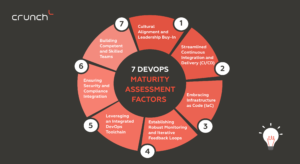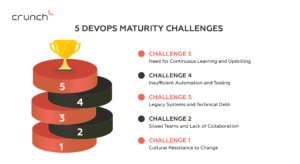Unlocking the full potential of DevOps practices is a quest for every forward-thinking organization. But how do you gauge your progress and identify areas for growth? Picture the DevOps Maturity Model as your trusty compass, guiding you through uncharted territories of efficiency and collaboration. By defining clear milestones and benchmarks, this model acts as a compass, guiding businesses toward higher levels of efficiency and collaboration.
In this article, we embark on a journey of discovery, exploring the depths of the DevOps Maturity Model and its profound impact on organizations. From identifying bottlenecks to streamlining workflows, we delve into the core of this model to uncover hidden opportunities for improvement.
Remember, Rome wasn’t built in a day, and likewise, achieving a remarkable level of DevOps maturity necessitates a steadfast commitment to continuous improvement, adaptation, and knowledge acquisition. So, buckle up and get ready to dive into the world of DevOps maturity!
What Maturity Assessment Can Say About Your DevOps Model
The DevOps maturity model is a framework that evaluates the level of advancement and effectiveness of an organization’s software development and delivery processes. It examines various aspects such as collaboration, automation, cultural alignment, and tooling to assess how well DevOps principles and practices are integrated and utilized. The model provides a structured approach to understanding the strengths and weaknesses of the organization’s DevOps implementation, allowing it to make informed decisions for continuous improvement and set realistic goals for enhancing software development and delivery capabilities.
Additionally, it allows you to measure progress over time and evaluate the effectiveness of your DevOps initiatives. Comparing your organization’s DevOps maturity with industry standards through benchmarks helps identify areas of improvement or areas where you excel.
Overall, a maturity assessment serves as a valuable tool for understanding the current state of your DevOps model and making informed decisions to enhance your software development and delivery practices.
7 DevOps Maturity Assessment Factors
Assessing the maturity level of a DevOps model involves considering a range of factors that reflect the degree of integration, automation, and collaboration within the organization.

These factors play a vital role in gauging the organization’s readiness to embrace DevOps practices and drive successful software development and delivery. Here are some key factors commonly used to evaluate DevOps maturity:
1. Cultural Alignment and Leadership Buy-In
This factor assesses the organization’s culture and the level of support and involvement from leadership in driving DevOps practices. It involves evaluating whether there is a shared understanding and commitment to collaboration, transparency, and continuous improvement across teams. Strong leadership buy-in encourages a positive work culture that promotes agility, innovation, and cross-functional cooperation.
2. Streamlined Continuous Integration and Delivery (CI/CD)
This factor focuses on the organization’s ability to automate and optimize the process of integrating code changes, running tests, and deploying software in a reliable and efficient manner. It concerns examining the extent of automation, frequency of code integration, effectiveness of testing practices, and the speed and reliability of software delivery.
3. Embracing Infrastructure as Code (IaC)
This factor looks at the organization’s adoption of practices that treat infrastructure as code, enabling infrastructure provisioning and management through automated scripts or configuration files. It involves evaluating the extent to which infrastructure provisioning is standardized, version-controlled, and aligned with application code.
Embracing IaC allows organizations to achieve consistent and reproducible infrastructure deployments, improving scalability, reliability, and traceability.
4. Establishing Robust Monitoring and Iterative Feedback Loops
This factor concentrates on the organization’s ability to collect and analyze data from the production environment, enabling proactive monitoring, issue detection, and continuous feedback. It affects setting up monitoring tools and processes to capture performance metrics, log data, and user feedback.
5. Leveraging an Integrated DevOps Toolchain
This factor evaluates the organization’s use of a cohesive set of tools and technologies across the software development lifecycle. It applies to examining the integration and interoperability of tools for version control, continuous integration, automated testing, configuration management, deployment automation, and collaboration.
A well-integrated toolchain allows teams to streamline workflows, reduce manual effort, and foster seamless communication and collaboration.
6. Ensuring Security and Compliance Integration
This factor assesses how security and compliance practices are integrated into the DevOps processes. It evaluates the implementation of security controls, and vulnerability management practices, secures coding standards, and adherence to industry regulations and compliance requirements.
Ensuring security and compliance throughout the DevOps lifecycle helps mitigate risks, protect sensitive data, and maintain trust with customers and stakeholders.
7. Building Competent and Skilled Teams
This factor focuses on the skills, knowledge, and expertise of the teams involved in DevOps practices. It involves evaluating the level of competency in areas such as automation, cloud technologies, containerization, infrastructure management, and modern software delivery practices. Organizations need to invest in training, cross-functional collaboration, and continuous learning to equip their teams with the necessary skills to effectively implement and maintain DevOps practices.
In a nutshell, conducting a thorough assessment of DevOps maturity helps organizations understand their current state and areas to improve. By aligning culture and leadership, streamlining CI/CD processes, embracing Infrastructure as Code, establishing strong monitoring and feedback loops, utilizing an integrated toolchain, ensuring security and compliance integration, and building competent teams, organizations can enhance their DevOps capabilities. This allows them to drive innovation, improve software quality and delivery speed, increase operational efficiency, and achieve business goals.
A solid DevOps foundation promotes collaboration, empowers teams, and helps organizations stay competitive in today’s fast-changing digital landscape. Building a strong DevOps ecosystem ensures staying ahead in a rapidly evolving market, where time-to-market is critical, and competitiveness is essential. By carefully assessing and addressing each factor, organizations can pave the way for sustained success in software development and delivery.
4 Phases of the DevOps Maturity Model
The DevOps Maturity Model comprises distinct levels that represent the progressive stages of an organization’s journey toward a highly mature and efficient DevOps environment. These levels can be seen as stepping stones, each qualitatively different from the others, as organizations transition from one to another. Let’s explore.
1. Foundational Level
This initial stage sets the cornerstone for DevOps adoption. At this level, organizations focus on establishing a solid bedrock by fostering a collaborative culture, embracing fundamental automation and version control practices, and promoting cross-functional communication.
It’s like laying the groundwork for a strong and stable structure, creating a platform for further growth.
2. Standardization Level
As organizations progress to this stage, they prioritize standardizing DevOps practices and tools across teams and projects. They strive to achieve consistency in workflows, cultivate the use of shared best practices, and adopt automation more comprehensively.
This level can be likened to the process of establishing standardized procedures and guidelines, ensuring a uniform approach throughout the organization.
3. Optimization Level
In this phase, organizations concentrate on optimizing their DevOps practices for maximum efficiency and effectiveness. They leverage advanced automation techniques, implement robust monitoring and feedback mechanisms, and integrate continuous integration and delivery (CI/CD) pipelines. This level can be seen as fine-tuning operations, eliminating inefficiencies, and continuously improving processes to achieve peak performance.
4. Transformation Level
This phase represents a significant shift towards a highly evolved DevOps model. Organizations in this stage exhibit a transformative mindset, where DevOps is deeply ingrained in the organization’s DNA. They embrace cutting-edge technologies, such as containerization and cloud-native architectures, and fully leverage advanced automation, artificial intelligence, and machine learning capabilities.
Collaboration, innovation, and agility become the norm, driving exponential growth and competitive advantage.
The number of levels or phases in a DevOps Maturity Model can range from three to five or more, depending on the specific framework or model being followed. The purpose of these levels is to provide a structured progression and assessment of an organization’s DevOps capabilities.
For instance, some models may include additional levels such as Advanced, Transformation, or Enterprise, representing further maturity and sophistication in DevOps practices. These additional levels often involve aspects like extensive automation, advanced cloud adoption, cultural transformation, and a strong focus on business outcomes.
The specific number of levels and their definitions may vary depending on the context, organization size, industry, and the chosen DevOps maturity framework. It’s essential for organizations to select a model that aligns with their specific goals, objectives, and cultural context, enabling them to assess their current state, identify areas for improvement, and track their progress on the DevOps maturity journey.
How to Assess Your DevOps Model?
To level up your DevOps game and achieve the best results, it’s essential to assess the current state of your DevOps model. So, let’s roll up our sleeves and take a closer look at how we can evaluate the maturity of your DevOps practices.
- Clearly Define Assessment Goals: Clearly articulate the objectives of your assessment, such as evaluating the effectiveness of your DevOps practices, identifying areas for optimization, or measuring the impact on business outcomes. This step sets the direction for the assessment and helps align it with your organization’s goals.
- Establish Evaluation Criteria: Set up specific evaluation criteria to assess the maturity of your DevOps model. Consider factors like release frequency, deployment success rate, MTTR, IaC adoption, and the utilization of automated testing and monitoring tools. These criteria provide a framework for measuring progress and identifying areas of strength or weakness.
- Gather Comprehensive Data: Collect data from various sources to obtain a comprehensive view of your DevOps practices. This includes examining configuration management systems, version control repositories, deployment logs, and incident reports. Engage with development, operations, and quality assurance teams to gather insights and understand their experiences.
- Evaluate Cultural Alignment and Leadership: Assess the degree of cultural alignment and leadership support for DevOps initiatives. Evaluate factors such as collaboration between teams, empowerment of individuals, and sponsorship from senior management. Determine if there is a culture of innovation and continuous improvement, where teams are encouraged to take ownership and drive positive change.
- Scrutinize Processes and Workflows: Analyze your processes and workflows to identify areas for improvement. Evaluate the efficiency of code integration, testing procedures, release management, and incident response. Look for opportunities to streamline and automate these processes using appropriate tools and technologies.
- Assess Automation and Tooling: Evaluate the level of automation and effectiveness of the tools used in your DevOps practices. Assess areas such as infrastructure provisioning, configuration management, continuous integration and deployment, automated testing, and monitoring. Identify gaps where automation can be introduced or enhanced to improve efficiency and reduce manual effort.
- Measure Key Metrics and Performance: Define and measure key metrics related to your DevOps practices. These metrics may include cycle time, lead time, deployment frequency, change failure rate, and customer satisfaction. Use these metrics to track progress over time and identify areas that require attention or optimization.
- Identify Strengths and Areas for Improvement: Analyze the assessment findings to identify strengths and areas for improvement. Determine which aspects of your DevOps model are performing well and should be reinforced, as well as which areas require attention or remediation. This analysis helps prioritize initiatives and allocate resources effectively.
- Develop a Concrete Action Plan: Based on the assessment results, create a detailed action plan that outlines specific initiatives, timelines, and responsible stakeholders. Break down the plan into actionable steps, leveraging phrasal verbs and business IT vocabulary to communicate tasks effectively. Ensure that the action plan is aligned with your organization’s overall strategy and goals.
- Monitor Progress and Iterate: Continuously monitor the progress of your DevOps initiatives and regularly reassess your maturity level. Track the implementation of the action plan, measure key metrics, and solicit feedback from teams and stakeholders. Make iterative adjustments as needed to ensure continuous improvement and alignment with evolving business needs.
By diving into the steps outlined above, we can effectively evaluate the maturity of your DevOps practices, paving the way for improved outcomes and hitting your organizational targets.
DevOps Maturity Challenges
Embarking on the journey toward DevOps maturity is a pursuit that holds the potential for transformative outcomes for organizations. However, along the path to success, various challenges often arise, demanding careful consideration and strategic planning.
In this section, we delve into the obstacles encountered on the path to DevOps maturity and provide actionable strategies to overcome them. By addressing cultural resistance and tackling technical debt, we can unlock the full potential of DevOps practices.
Let’s take a closer look.

- Cultural resistance to change: This obstacle occurs when there is a lack of buy-in or reluctance to embrace new ways of working. To address this challenge, organizations should focus on fostering a culture of collaboration, innovation, and continuous improvement. Encourage open communication, provide training and education to help employees understand the benefits of DevOps, and showcase success stories to inspire adoption.
- Siloed teams and lack of collaboration: Siloed teams and limited collaboration between different departments can hinder the flow of information and slow down the DevOps transformation. To overcome this challenge, organizations should promote cross-functional collaboration and break down silos. Encourage teams to work together, establish shared goals and metrics, and foster a culture of knowledge sharing and collaboration.
- Legacy systems and technical debt: Legacy systems and accumulated technical debt can pose challenges in implementing DevOps practices. Organizations should prioritize addressing technical debt by identifying and prioritizing areas for improvement, refactoring code, and modernizing systems. Additionally, adopting practices such as continuous integration and automated testing can help mitigate the risks associated with legacy systems.
- Insufficient automation and tooling: Insufficient automation and outdated tooling can hinder the efficiency and effectiveness of DevOps practices. Organizations should invest in modern automation tools that streamline development, testing, deployment, and monitoring processes. Embrace IaC principles, adopt configuration management tools, and leverage continuous integration and deployment pipelines to automate manual tasks and improve overall efficiency.
- Need for continuous learning and upskilling: DevOps is a rapidly evolving field, and organizations need to prioritize continuous learning and upskilling of their teams. Provide training programs, encourage employees to pursue certifications, and establish a culture of learning. Foster knowledge sharing within teams and provide opportunities for professional growth to keep up with the latest trends and technologies in DevOps.
By proactively addressing these challenges and implementing the suggested strategies, organizations can overcome barriers to DevOps maturity and create a foundation for successful transformation. It requires a concerted effort, ongoing evaluation, and a commitment to continuous improvement to achieve the desired outcomes and reap the full benefits of DevOps practices.
DevOps Maturity Trends
Innovation is the lifeblood of organizational growth, and staying ahead in today’s competitive landscape requires the ability to adapt and deliver solutions quickly. Failure to innovate can lead to the decline of once industry-leading companies like Nokia, Kodak, and Blockbuster. To meet the demands of modern consumers, organizations need to launch products swiftly without compromising quality. This is where DevOps, a process innovation in the IT industry, comes into play.
According to the findings of GitLab’s DevSecOps survey, the rhythms of software release, automation, and security postures have witnessed a meteoric rise. Organizations are not merely adapting; they are thriving by harnessing cutting-edge technologies like artificial intelligence and machine learning to propel their DevOps practices to new heights.
Consider these staggering statistics from the study:
- Over half of the developers surveyed are unleashing code into the world twice as fast as before, like a well-oiled software machine in overdrive.
- The percentage of security pros giving their organizations’ security efforts a hearty thumbs-up has surged by a formidable 13% to reach an impressive 72%.
- Operations team members, once grappling with manual toil, now proudly proclaim that their processes are “fully” or mostly automated, boasting a 10% uptick from the year gone by.
- The realms of automation have expanded to the realm of testing, with nearly a quarter of respondents achieving the coveted status of full test automation, a remarkable 13% leap from the prior year.
- The siren call of AI/ML and test/code review bots have grown louder, with a jaw-dropping 41% surge in their adoption or planned implementation, signifying a new era of efficiency and innovation.
These trends paint a vivid picture of an industry hurtling forward with velocity, embracing agility, and harnessing the power of advanced technologies.
So, whether you’re a trailblazer just starting your DevOps adventure or a seasoned veteran seeking new horizons, buckle up and embrace the winds of change. The future belongs to those who dare to ride the crest of innovation and unlock the full potential of DevOps.
Consider Crunch Your Trusted DevOps Services Provider
As a seasoned DevOps enabler, Crunch has been instrumental in empowering organizations of all scales to embrace DevOps practices seamlessly across their software development lifecycle, turbocharging software delivery while minimizing potential bugs or downtimes. Our team of seasoned DevOps engineers incessantly focuses on KPIs during project execution, often advocating a KPI-driven approach for our esteemed clients.
In a recent endeavor, we architected an automated CI/CD pipeline to revolutionize the delivery process for a prominent US-based clientele. Our tech mavens diligently orchestrated a seamless integration and delivery (CI/CD) pipeline, seamlessly migrating core operations to the AWS cloud, streamlining error detection pre-release, and accelerating software deployments.
As a result, our collaboration yielded a staggering 73% reduction in costs through automation, cementing a fruitful 3-year partnership. Throughout the project, we meticulously tracked vital metrics like the mean time between releases (MTBR), error rate, deployment frequency, customer satisfaction, and more.
Our DevOps team boasts extensive proficiency in infrastructure-as-code (IaC) deployment, container orchestration, site reliability engineering (SRE) services, seamless implementation of continuous integration, continuous deployment (CI/CD), and an array of other cutting-edge practices. Whether you aspire to forge a DevOps strategy from the ground up or refine your existing processes, our DevOps experts are poised to offer their unwavering support, propelling your business to stay firmly ahead of the curve.
Take the leap towards DevOps excellence. Connect with us today to embark on your transformative journey and witness the remarkable potential of a finely tuned DevOps ecosystem.






![10 Top DevOps KPIs to Track [and no more] - Crunch.is](https://crunch.is/wp-content/uploads/2023/03/03-855x600.png)

